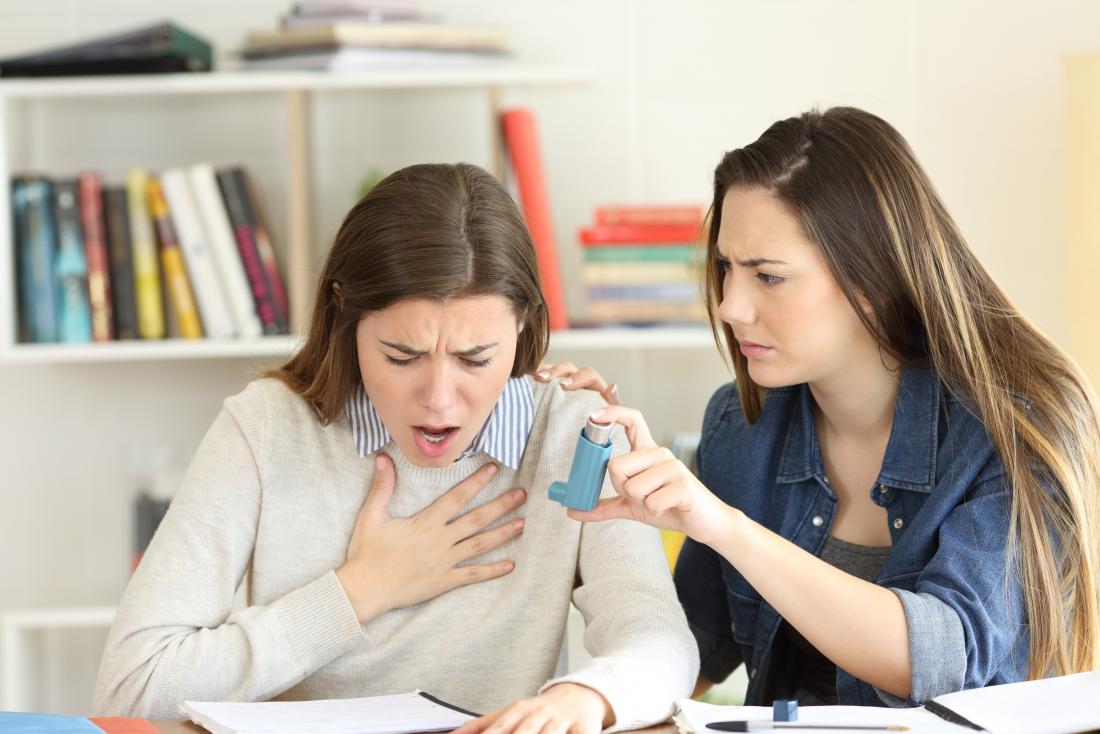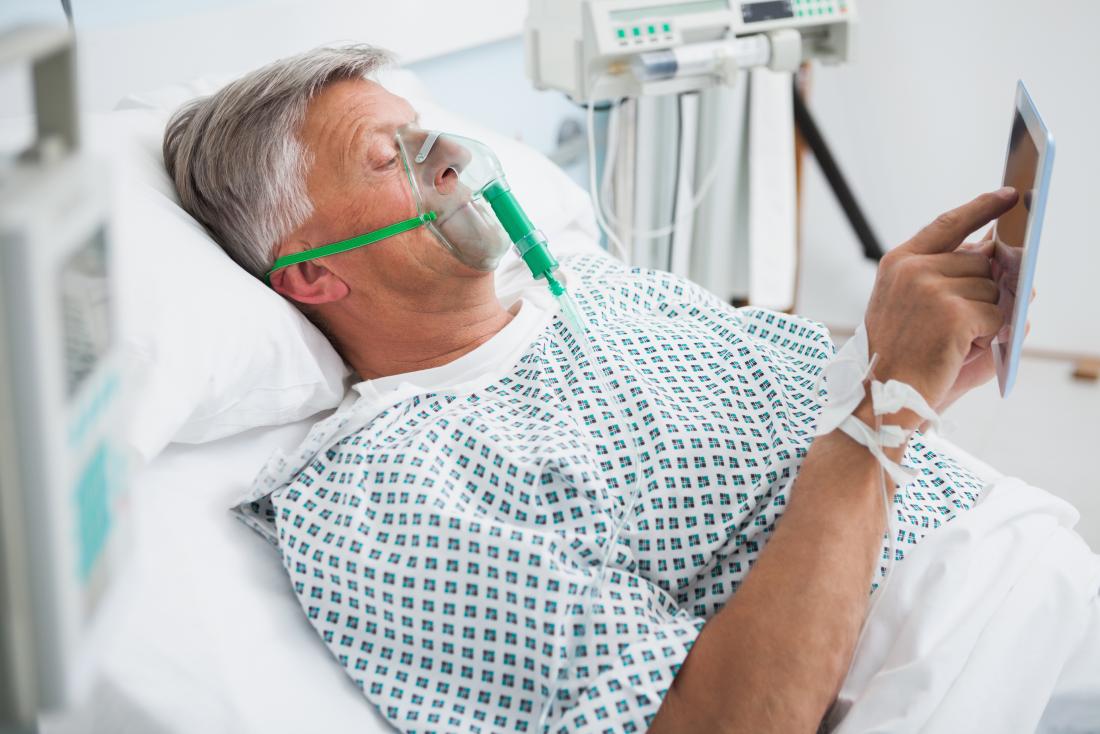Excercise Causing Sudden Onset and Continuing Shortness of Breath
Dyspnea is the medical term for shortness of breath, sometimes described as "air hunger." It is an uncomfortable feeling.
Shortness of breath can range from mild and temporary to serious and long-lasting. It is sometimes difficult to diagnose and treat dyspnea because there can be many different causes.
It is a common problem. According to the Cleveland Clinic Center for Continuing Education, 1 in every 4 people who visit the doctor have dyspnea.

Breathing problems can result from overexertion in otherwise healthy people.
Dyspnea can happen as a result of overexertion, spending time at high altitude, or as a symptom of a range of conditions.
Signs that a person is experiencing dyspnea include:
- shortness of breath after exertion or due to a medical condition
-
feeling smothered or suffocated as a result of breathing difficulties - labored breathing
- tightness in the chest
- rapid, shallow breathing
-
heart palpitations - wheezing
- coughing
If dyspnea occurs suddenly or if symptoms are severe, it may be a sign of a serious medical condition.
An episode of dyspnea is not always directly related to an individual's health. A person can feel short of breath after intense exercise, when traveling to a high altitude, or going through major temperature changes.
However, dyspnea usually relates to health problems. Sometimes, it is just a case of being out of shape, and exercise can improve symptoms. But dyspnea can be a sign of a serious health issue.
According to Dr. Steven Wahls, the most common causes of dyspnea are asthma, heart failure, chronic obstructive pulmonary disease (COPD), interstitial lung disease, pneumonia, and psychogenic problems that are usually linked to anxiety.
If shortness of breath starts suddenly, it is called an acute case of dyspnea.
Acute dyspnea could be due to:
- asthma
- anxiety
- pneumonia
- choking on or inhaling something that blocks breathing passageways
- allergic reactions
- anemia
- serious loss of blood, resulting in anemia
- exposure to dangerous levels of carbon monoxide
- heart failure
- hypotension, which is low blood pressure
- pulmonary embolism, which is a blood clot in an artery to the lung
- collapsed lung
- hiatal hernia
Dyspnea is also common among people with a terminal illness.
If a person experiences shortness of breath for over a month, the condition is called chronic dyspnea.
Chronic dyspnea could be due to:
- asthma
- COPD
- heart problems
- obesity
- interstitial pulmonary fibrosis, a disease that causes scarring of the lung tissue
Some additional lung conditions may also cause shortness of breath.
Examples are:
- croup
- traumatic lung injury
- lung cancer
- tuberculosis
- pleurisy, an inflammation in the tissues surrounding the lungs
- pulmonary edema, when too much fluid collects in the lungs
- pulmonary hypertension, when the blood pressure in the arteries to the lungs rises
- sarcoidosis, when clusters of inflammatory cells grow in the lungs
Shortness of breath has also been linked to the following heart problems:
- cardiomyopathy, a range of diseases affecting the heart muscle
- heart rhythm problems
- heart failure
- pericarditis, when the tissue that surrounds the heart becomes inflamed
Triggers

Dyspnea is a symptom of asthma.
Environmental pollutants such as chemicals, fumes, dust, and smoke can make it more difficult for people with dyspnea to breathe.
People with asthma may find that exposure to allergens such as pollen or mold may trigger episodes of dyspnea.
Some pollutants, such as tobacco smoking, are self-administered and preventable.
COPD refers to different obstructive lung diseases. These include emphysema and chronic bronchitis.
All these conditions make breathing much more difficult.
Not everyone with dyspnea has COPD, but 90 percent of people with COPD were tobacco smokers at one point, according to the COPD Foundation.
Dyspnea can be associated with hypoxia or hypoxemia, which is a low blood oxygen levels. This can lead to a decreased level of consciousness and other severe symptoms.
If dyspnea is severe and continues for some time, there is
It can also be a sign of an onset or worsening of other medical problems.
Sometimes, shortness of breath can be a sign of a life-threatening condition.
Emergency medical treatment is needed if an individual has any of these symptoms:
- sudden onset of severe dyspnea
- loss of ability to function due to shortness of breath
- chest pain
- nausea
Not all cases of dyspnea call for immediate medical treatment, but shortness of breath can indicate serious medical problems.
Medical advice is needed if an individual experiences:
- a change in their ability to breathe
- increasing limits on their activities due to breathing problems
- difficulty breathing when lying down
- swelling in feet and ankles
- fever, chills, and a cough
- wheezing
A doctor will usually be able to diagnose dyspnea based on a complete physical examination of the person, along with a full description of their experiences, according to Dr. Wahls.
A person will need to explain how and when their attacks of dyspnea started, how long they last, how frequently they occur, and how severe they are.
Doctors may use chest X-rays and computed tomography (CT) images to make a more specific diagnosis of dyspnea and evaluate the health of the person's heart, lungs, and related systems.
An electrocardiogram (ECG) may help to show any signs of a heart attack or other electrical problem in the heart.
Spirometry tests to measure airflow and the patient's lung capacity. This can help to pinpoint the type and the extent of an individual's breathing problems. Additional tests can look at the level of oxygen in a patient's blood, and the blood's capacity to carry oxygen.

Oxygen therapy may be necessary in some circumstances.
Treatment will depend on the cause of the problem.
A person who is short of breath due to overexertion will probably get their breath back once they stop and relax.
In more severe cases, supplemental oxygen will be needed. Those with asthma or COPD may have an inhaled rescue bronchodilator to use when necessary.
For those with chronic conditions, such as COPD, a health care provider will work with the individual to help them breathe more easily.
This will involve developing a treatment plan that helps to prevent acute episodes and slow down progression of the overall disease.
If dyspnea is linked to asthma, it typically responds well to medications such as bronchodilators and steroids.
When it is due to an infection such as bacterial pneumonia, antibiotics can bring relief.
Other medications, such as opiates, non-steroidal anti-inflammatory drugs (NSAIDs), and anti-anxiety drugs, can also be effective.
Breathing troubles stemming from COPD can improve with special breathing techniques, such as pursed-lip breathing and breathing muscle strengthening exercises.
People can learn how to do these on pulmonary rehabilitation programs.
The Dyspnea Lab, a research center specializing in shortness of breath, report that people find these programs helpful, even if the root causes of the problem remains.
If tests indicate low levels of oxygen in the blood, supplemental oxygen may be supplied. However, not everyone with shortness of breath will have low blood oxygen levels.
According to the Dyspnea Lab, many people with dyspnea find that a gentle stream of cool air around the head and face helps improve their symptoms.

Quitting or avoiding smoking is important for preventing respiratory problems.
Individuals with dyspnea can take measures to improve their overall health and give themselves more breathing room.
These include:
- quitting smoking
- avoiding second-hand smoke where possible
- avoiding other environmental triggers such as chemical fumes and wood smoke
- losing weight, as this can reduce stress on the heart and lungs and make it easier to exercise, both of which can strengthen the cardiovascular and respiratory systems
- take time adjusting to higher altitudes, ease into activities gradually, and reduce exercise levels at altitudes above 5,000 feet
Dyspnea can affect specific groups of people in different ways:
Pregnancy
According to the Cleveland Clinic Center for Continuing Education, mild symptoms of dyspnea are common during pregnancy.
This is because pregnancy alters a woman's breathing capacity.
Breathing capacity increases during pregnancy, but there is also a reduction in lung volume of up to 20 percent at the end of an expiration.
The number of breaths a woman takes per minute, or the respiratory rate, does not typically change during pregnancy.
Older people and people with serious health conditions
Dyspnea can develop when people are experiencing the advanced stage of certain diseases.
At this point, shortness of breath may be dealt with as part of an end-of-life treatment package, as treating dyspnea with specific drugs may cause the person unnecessary problems.
Infants
Diseases of the upper respiratory system that cause acute dysnpea are a relatively common pediatric emergency. They are one of the most common causes of shortness of breath in infants.
Croup, inhaling a foreign object, and inflammation of the epiglottis are all common causes of dyspnea in infants.
The outlook for people with dyspnea depends on the cause.
If the underlying condition can be successfully treated and improved, such as pneumonia or non-severe asthma, then breathing problems may be eliminated or greatly reduced.
However, if shortness of breath is due to serious or chronic diseases that worsen over time, such as chronic heart failure, severe asthma, or COPD, improvement may be limited.
Patients with dyspnea need to work with their healthcare providers to develop and follow a comprehensive treatment plan.
Read the article in Spanish.
Source: https://www.medicalnewstoday.com/articles/314963
0 Response to "Excercise Causing Sudden Onset and Continuing Shortness of Breath"
Postar um comentário